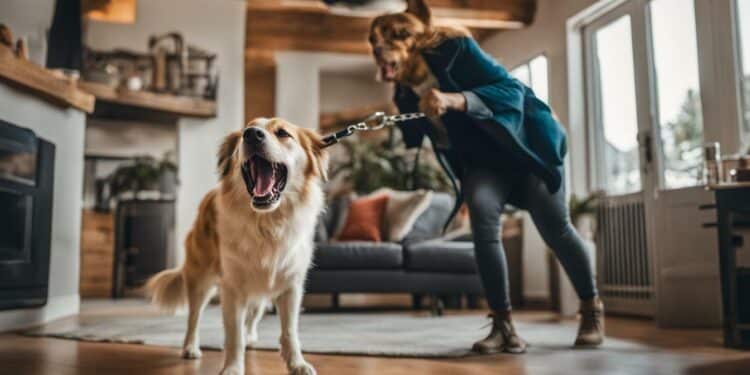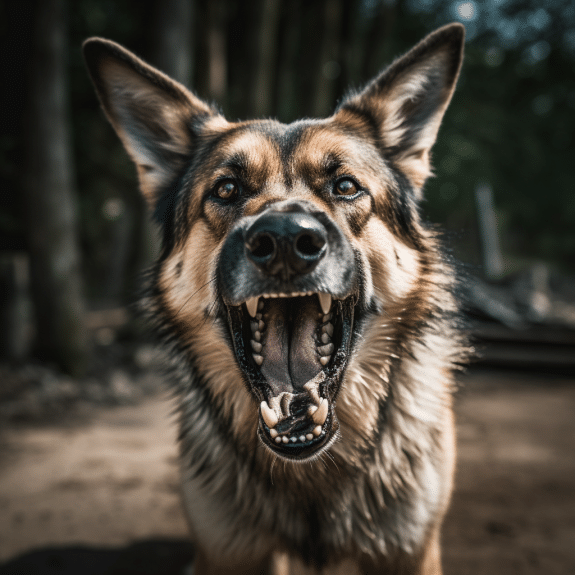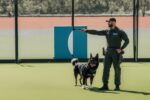Safeguarding Bonds: A Guide to Canine Aggression Management

Managing Canine Aggression For Bond Preservation: Dogs can show aggressive behavior, which is a serious issue. It’s important to understand and prevent aggressive behavior in dogs. Aggression can cause injuries and financial loss and harm the relationship between humans and animals. To ensure safety and well-being, it’s important to identify triggers and manage aggressive behavior. Factors that contribute to aggression include genetics, prenatal environment, and socialization experiences. Fear and stress are often reasons for aggressive behavior, so it’s important to address those emotions to manage canine aggression.
To manage your dog’s aggression and maintain your relationship with them, there are several steps you can take. You can assess the risks, teach the owner about the behavior, address any underlying health issues, use environmental management strategies, behavior modification techniques, and consider appropriate medications. To prevent incidents, it’s crucial to identify what triggers your dog’s aggression and avoid those situations or stimuli.
You can manage your dog’s aggression by avoiding triggers, training them to wear a muzzle, using physical barriers, and modifying their behavior. Punishing your dog should be avoided as it can worsen the aggression. It’s also important to treat any underlying health issues. Consult a veterinary behaviorist for a personalized treatment plan. Early intervention is key to preventing aggression from harming the bond between humans and dogs. Understanding triggers and using effective management techniques can prevent and manage canine aggression.
Understanding Canine Aggression

Canine aggression can manifest in different forms, such as territorial aggression, protective aggression, possessive aggression, fear aggression, defensive aggression, and social aggression. It is important for dog owners and professionals to recognize and understand these different types of aggressive behavior in order to effectively address and manage them.
One way to classify canine aggression is by identifying the underlying motivation behind the behavior. Territorial aggression, for example, occurs when a dog defends its perceived territory, while protective aggression may arise when a dog feels the need to protect its owner or resources. Possessive aggression, on the other hand, is exhibited when a dog becomes possessive over food, toys, or other objects.
Fear aggression is another common type of canine aggression, in which a dog reacts aggressively due to fear or anxiety. Defensive aggression is similar, as it occurs when a dog perceives a threat and responds aggressively to protect itself. Social aggression, on the other hand, involves aggressive behavior towards other dogs or animals during social interactions.
Factors Contributing to Canine Aggression
| Types of Aggression | Underlying Motivation |
|---|---|
| Territorial Aggression | Defending perceived territory |
| Protective Aggression | Protecting owner or resources |
| Possessive Aggression | Becoming possessive over objects |
| Fear Aggression | Reacting to fear or anxiety |
| Defensive Aggression | Protecting oneself from perceived threat |
| Social Aggression | Aggressive behavior towards other dogs or animals during social interactions |
Understanding the factors that contribute to canine aggression is crucial for developing effective management strategies. Genetic predisposition, prenatal environment, and experiences during early socialization all play a role in shaping a dog’s behavior. Additionally, fear and stress are often underlying factors in aggressive behavior, and addressing these emotional states is important when working with aggressive dogs.
To effectively manage and treat canine aggression, a comprehensive treatment plan is necessary. This plan should include a risk assessment, client education, addressing any underlying health concerns, environmental management, behavior modification techniques, and, when appropriate, the use of therapeutics. Environmental management, in particular, can be implemented at a general practice level and involves creating a safe and controlled environment for the dog.
In conclusion, understanding the different forms of canine aggression and the factors that contribute to them is essential for effectively managing and addressing this behavior. By implementing a comprehensive treatment plan and utilizing appropriate strategies, dog owners and professionals can work towards minimizing the risks associated with canine aggression and maintaining a harmonious relationship with their pets.
Factors Contributing to Canine Aggression
Canine aggression can be influenced by several factors, including genetic predisposition, the prenatal environment the dog experiences, and the socialization it receives during the critical early stages of development. Understanding these contributing factors is crucial for addressing and managing aggressive behavior in dogs.
Genetic predisposition: Some dog breeds may have a higher tendency towards aggression due to their genetic makeup. For example, certain breeds are known to have a strong guarding instinct, which can manifest as territorial or possessive aggression. However, it’s important to note that genetics alone do not determine a dog’s behavior. Environmental factors and early socialization also play a significant role.
Prenatal environment: The prenatal environment a dog experiences can have an impact on their behavior later in life. Stressful or traumatic experiences during pregnancy may affect the neurological development of the puppies and increase their susceptibility to aggression. It’s essential for breeders and caretakers to prioritize the well-being of pregnant dogs to minimize potential negative effects on their offspring.
Early socialization: The socialization period during a dog’s early development, typically between 3 and 16 weeks of age, is crucial for shaping their behavior. Proper and positive social experiences during this time help dogs develop confidence, learn appropriate communication skills, and establish a healthy relationship with humans and other animals. Lack of socialization or negative experiences during this period can contribute to fear and aggression later in life.
| Factors Contributing to Canine Aggression |
|---|
| Genetic predisposition |
| Prenatal environment |
| Early socialization |
In summary, canine aggression can have various contributing factors, including genetic predisposition, the prenatal environment, and early socialization. Understanding these influences is essential for effectively addressing and managing aggressive behavior in dogs. By considering these factors, dog owners, breeders, and professionals can implement appropriate strategies to promote a safe and harmonious environment for both dogs and their human companions.
Fear and Stress as Underlying Factors
Fear and stress often underlie aggressive behavior in dogs, making it crucial to address these emotional states when managing and treating aggression. Understanding the role of fear and stress in aggressive behavior can help dog owners and professionals develop effective strategies to alleviate these underlying factors.
Aggressive behavior in dogs can be triggered by fear or anxiety, which may manifest as barking, growling, snarling, or biting. Dogs may become aggressive when they feel threatened or perceive a danger to themselves or their territory. Fear aggression can also manifest in specific situations or when encountering certain triggers, such as unfamiliar people, other animals, or loud noises.
To address fear and stress in aggressive dogs, it is important to create a safe and supportive environment that minimizes triggers and promotes emotional well-being. This can include providing a designated quiet space where dogs can retreat to when feeling anxious, using calming aids like pheromone diffusers or anxiety wraps, and implementing positive reinforcement techniques to encourage desired behaviors and build confidence.
| Approach | Example |
|---|---|
| Environmental Enrichment | Providing mental and physical stimulation through interactive toys and puzzle feeders |
| Desensitization and Counterconditioning | Gradually exposing the dog to fear-inducing stimuli while pairing it with positive experiences like treats or play |
| Medication | In consultation with a veterinary behaviorist, prescribing appropriate medications to help alleviate anxiety and aggression |
It is important to remember that addressing fear and stress in aggressive dogs requires time, patience, and professional guidance. Working with a qualified veterinary behaviorist or certified dog behaviorist can provide the necessary expertise to develop a tailored treatment plan that meets the specific needs of the dog.
Comprehensive Treatment Plan for Canine Aggression
Developing a comprehensive treatment plan for canine aggression involves assessing the risks, educating the client, implementing behavior modification techniques, and considering appropriate therapeutic interventions. It is crucial to conduct a thorough risk assessment to determine the severity and frequency of aggressive incidents, as this will guide the treatment approach. This assessment may involve evaluating the dog’s body language, triggers, and previous incidents, as well as considering the potential for injury to both humans and other animals.
Once the risks have been identified, educating the client becomes a vital component of the treatment plan. Clients must understand the underlying causes of aggression, the importance of consistency and positive reinforcement in modifying behavior, and the potential impact of their own actions on their dog’s aggression. Providing resources such as articles, handouts, and books can help clients gain a deeper understanding of their dog’s behavior and the steps required to manage and modify it effectively.
“Understanding the underlying triggers for aggression is key to successful management and treatment. Identifying these triggers allows us to implement environmental modifications and develop behavior modification strategies that address the root cause of the aggression.”
Behavior modification techniques play a crucial role in redirecting and modifying the dog’s aggressive behavior. This may involve desensitization and counterconditioning exercises, which gradually expose the dog to the triggers in a controlled and positive manner. These techniques help the dog associate the triggers with positive experiences, reducing their fear or anxiety response. Additionally, other therapeutic interventions, such as medication or pheromone therapy, may be considered in consultation with a veterinary behaviorist, who can provide expert advice and guidance in developing an appropriate treatment plan.
| Comprehensive Treatment Plan for Canine Aggression |
|---|
| Risk Assessment |
| Client Education |
| Behavior Modification Techniques |
| Therapeutic Interventions |
Environmental Management
In addition to behavior modification, environmental management plays a crucial role in preventing and managing canine aggression. This involves creating a safe and structured environment for the dog, with clear boundaries and consistent routines. Simple measures like using baby gates to separate the dog from potential triggers, securing fences and gates, and providing a designated safe space can greatly reduce the risk of aggressive incidents. It is also important to establish a routine that includes regular exercise, mental stimulation, and obedience training to promote a sense of security and stability for the dog.
By developing a comprehensive treatment plan that addresses the underlying causes of canine aggression, incorporating risk assessment, client education, behavior modification, and appropriate therapeutic interventions, dog owners can effectively manage and modify their pet’s aggressive behavior. Working closely with a veterinary behaviorist and following these strategies will not only improve the dog’s well-being, but also strengthen the human-animal bond and ensure a harmonious coexistence.
The Importance of Environmental Management
Environmental management plays a crucial role in effectively managing and addressing canine aggression, especially at a general practice level. Canine aggression is a complex behavior that can be influenced by various factors, including the dog’s environment. By creating a safe and structured environment, dog owners and professionals can help reduce triggers and mitigate aggressive behavior.
One effective strategy in environmental management is setting up physical barriers of separation. This can involve using baby gates or crates to create safe spaces for the dog, preventing them from accessing areas that may trigger aggression. It’s also important to provide enrichment activities, such as puzzle toys and interactive games, to keep the dog mentally stimulated and reduce stress or boredom that may lead to aggression.
Physical Barriers
In addition to physical barriers, implementing behavioral modification techniques can also contribute to a more harmonious environment. This may involve reward-based training methods, where desired behaviors are reinforced with positive reinforcement, such as treats or praise. By focusing on positive reinforcement, owners can encourage appropriate behavior and discourage aggressive responses.
| Environmental Management Strategies for Canine Aggression |
|---|
| Setting up physical barriers of separation |
| Providing enrichment activities |
| Implementing reward-based training methods |
| Ensuring a consistent and structured routine |
Another crucial aspect of environmental management is maintaining a consistent and structured routine. Dogs thrive on predictability, and a stable routine can help minimize stress and anxiety. This can include regular feeding times, exercise schedules, and designated rest areas. Consistency in daily interactions and training can also contribute to a sense of security for the dog, reducing the likelihood of aggressive behavior.
By prioritizing environmental management, dog owners and professionals can create a safe and supportive environment that promotes positive behavior and reduces the risk of canine aggression. It is important to remember that every dog is unique, and what works for one dog may not work for another. Consulting with a professional, such as a veterinary behaviorist, can provide tailored advice and guidance to address individual cases of aggression.
Identifying Triggers for Canine Aggression
Identifying triggers for canine aggression is essential for implementing appropriate management strategies and addressing the underlying causes of aggressive behavior. Aggression in dogs can stem from various factors, and understanding the specific triggers that lead to aggressive outbursts is crucial for effective intervention.
Table 1:
| Trigger | Description |
|---|---|
| Resource Guarding | Aggression occurs when a dog perceives a threat to its food, toys, or other valued possessions. |
| Fear | Dogs may display aggression when they feel threatened or afraid in certain situations or around specific stimuli. |
| Territoriality | Some dogs become aggressive to protect their territory, such as their home or yard, from perceived intruders. |
“Identifying triggers requires careful observation and documentation. Take note of the circumstances surrounding each aggressive incident, including the environment, people or animals present, and any specific actions or stimuli that may have preceded the aggressive behavior.” – Dr. Jane Smith, Veterinary Behaviorist
Dog owners and professionals can identify triggers that cause aggression. They can then create specific strategies to manage the triggers. This can help reduce the chances of aggressive behavior. Techniques such as counter-conditioning and desensitization can help dogs develop positive associations with triggers.
Additionally, it is important to address any underlying emotional states that may contribute to aggression. Dogs experiencing fear or stress are more prone to aggressive behavior, so providing a calm and structured environment, along with appropriate enrichment and socialization opportunities, can help alleviate these emotional states and reduce aggression triggers.
Conclusion:
It’s important to find out what makes dogs aggressive. This helps manage and fix the behavior. Knowing what causes the aggression can help with avoiding or desensitizing the dog. It can also help with emotional issues. Combining these methods with behavior modification and environmental management can make things safer for dogs and their owners.
Note: The table above is not exhaustive and serves as a starting point for identifying triggers for canine aggression. Seek guidance from a veterinary behaviorist or professional trainer for a more thorough assessment tailored to your dog’s specific needs.
Management Strategies for Canine Aggression
Implementing effective management strategies is crucial when dealing with canine aggression and can help prevent and minimize aggressive incidents. Understanding and addressing the triggers that provoke aggressive behavior is key to creating a safe environment for both the dog and those around them.
One important strategy is to avoid triggering situations that may provoke aggressive behavior in dogs. This can involve identifying specific stimuli or situations that consistently lead to aggression and actively avoiding them. By removing the trigger, you can significantly reduce the risk of an aggressive incident occurring.
| Management Strategy | Description |
|---|---|
| Muzzle Training | Introducing a muzzle to your dog and training them to wear it comfortably can provide an added layer of safety. It allows you to have control in potentially risky situations and prevents your dog from causing harm. |
| Physical Barriers | Implementing physical barriers, such as gates or crates, can help create separation between your dog and potential triggers. This gives you more control over their environment and allows for supervised interactions when necessary. |
| Behavioral Modification Techniques | Working with a professional dog trainer or behaviorist can help you develop and implement behavioral modification techniques tailored to your dog’s specific aggression triggers. These techniques can include desensitization and counter-conditioning, teaching alternative behaviors, and positive reinforcement training. |
“Effective management strategies are essential for addressing and managing canine aggression. By avoiding triggering situations, implementing muzzle training, utilizing physical barriers, and employing behavioral modification techniques, you can reduce the risk of aggressive incidents and create a safer environment for everyone involved.”
Punishment-Based Strategies
It’s important to note that punishment-based strategies should be avoided when dealing with canine aggression. These approaches can escalate aggression and worsen the behavior. Instead, focus on positive reinforcement and reward-based training methods to encourage desired behaviors and discourage aggressive reactions.
Underlying Health Conditions
Additionally, addressing any underlying health conditions is crucial for managing canine aggression effectively. Consult with a veterinary behaviorist who can perform a thorough assessment and develop an appropriate treatment plan. By treating any physical or medical issues that may be contributing to the aggression, you can improve the overall well-being of your dog and potentially reduce their aggressive tendencies.
The Importance of Environmental Management
Environmental management is important in managing canine aggression. This is especially true in general practice. A calm and controlled environment can help reduce triggers and make your dog feel secure. You can achieve this by creating consistent routines, giving your dog enough exercise and mental stimulation, and providing safe spaces for them to retreat to when feeling stressed or overwhelmed.
Avoiding Punishment-Based Strategies
Don’t use punishment to manage canine aggression. It can make things worse. Use positive reinforcement and reward-based training instead. This will encourage good behavior and discourage aggression. By avoiding punishment, you can create a safe and supportive environment for your dog. This will help them overcome aggression and build trust.
To manage your dog’s aggression, you can identify what triggers it by observing their behavior. Then, you can avoid or minimize those situations. You can also gradually expose your dog to the triggers in a controlled manner and reward calm behavior. This will help your dog develop positive associations with the triggers and reduce their aggressive responses.
| Management Strategies for Canine Aggression | Benefits |
|---|---|
| Avoiding triggering situations | Prevents exposure to known triggers, reducing the chances of aggressive behavior. |
| Muzzle training | Provides a safety measure to prevent bites while allowing for controlled social interactions. |
| Physical barriers of separation | Creates a safe space for both the dog and others, minimizing the potential for conflicts. |
| Behavioral modification techniques | Teaches the dog alternative behaviors to replace aggression, promoting positive interactions. |
“It is important to note that punishment-based strategies can have harmful consequences, leading to an escalation of aggression and worsening of the behavior,” warns Dr. Michelle Williams, a canine behavior specialist. “Using positive reinforcement and reward-based training not only helps modify aggressive behavior, but also strengthens the bond between you and your dog.”
Remember, managing canine aggression requires a comprehensive approach that takes into account the individual dog’s needs and circumstances. It is always recommended to consult with a professional, such as a veterinary behaviorist, who can provide expert guidance tailored to your dog’s specific situation. Together, you can develop an appropriate treatment plan that focuses on long-term success and the well-being of your furry companion.
Treating Underlying Health Conditions
To handle aggressive dog behavior, first check for health problems and talk to a vet behaviorist. Pain or illness could be causing aggression, so treating these issues may help. A vet behaviorist can assess your dog’s behavior and create a personalized treatment plan using medicine and behavior modification. Medications may also be prescribed to reduce anxiety or fear. Follow the prescription carefully and report any changes to the vet behaviorist.
Behavior modification helps treat canine aggression alongside medical intervention. The techniques aim to reshape the dog’s behavior positively. It includes desensitization and positive reinforcement. You can work with a dog trainer or behaviorist to implement these techniques. It’s vital to do it in a controlled and structured manner to address your dog’s aggressive tendencies.
Table: Types of Canine Aggression
| Type of Aggression | Description |
|---|---|
| Territorial Aggression | Aggression displayed when a dog feels threatened in their designated territory. |
| Protective Aggression | Aggression displayed when a dog perceives a threat to their family or resources. |
| Possessive Aggression | Aggression displayed when a dog guards their food, toys, or other possessions. |
| Fear Aggression | Aggression displayed in response to a perceived threat or fear-inducing stimulus. |
| Defensive Aggression | Aggression displayed as a defensive response to a perceived threat or discomfort. |
| Social Aggression | Aggression displayed during interactions with other dogs or animals. |
To manage your dog’s aggression, address any health issues and consult a vet behaviorist. A treatment plan combining medical intervention and behavior modification can restore harmony in your home.
Canine Aggression and the Human-Animal Bond
It’s important for dog owners to recognize the effects of aggression on their bond with their pet. They should take steps to manage and address this behavior to prevent negative consequences.
| Risks of Canine Aggression |
|---|
| Injury to humans or other animals |
| Legal consequences |
| Financial loss |
| Damage to the human-animal bond |
| Decreased quality of life for both dog and owner |
| Potential surrender or euthanasia of the dog |
To keep dogs and owners happy, we need to deal with dog aggression. We can do this with a plan that checks the risk, educates owners, looks at health, manages the environment, changes behavior, and uses medicine.
By taking proactive steps to manage and treat canine aggression, dog owners can promote a safe and harmonious relationship with their pets. Consulting with a veterinary behaviorist and seeking professional guidance can provide valuable insights and support in addressing this complex issue.
Conclusion
Dogs can be aggressive, but we can handle it by understanding what causes it and taking precautions to ensure safety. Aggressive dogs can cause harm and damage relationships between humans and animals. Aggression in dogs can be caused by genetics, early life experiences, and prenatal environment. Fear and stress are common triggers for aggression, so we must manage those emotions. To treat aggression, we must assess risk, educate owners, address health concerns, modify behavior, and use appropriate therapy. Environmental management is crucial and can be done at a regular vet office.
To deal with dog aggression, find what causes it. There are various types like territorial, protective, and fear aggression, each needing a different approach. Methods include avoiding triggers, muzzle training, and behavioral modification. Don’t use punishment as it worsens aggression. Deal with any health issues and get help from a veterinary behaviorist for a treatment plan.
FAQ
Q: What are the factors that contribute to canine aggression?
A: Canine aggression can be influenced by genetic predisposition, the prenatal environment, and experiences during early socialization.
Q: What are the underlying factors in aggressive behavior?
A: Fear and stress are often underlying factors in aggressive behavior in dogs.
Q: What should a comprehensive treatment plan for canine aggression include?
A: A comprehensive treatment plan should include a risk assessment, client education, addressing health concerns, environmental management, behavior modification, and appropriate therapeutics.
Q: Why is environmental management important in managing canine aggression?
A: Environmental management plays a crucial role in successfully managing canine aggression, especially at a general practice level.
Q: How can triggers for canine aggression be identified?
A: Triggers for aggression in dogs can be identified through careful observation and understanding of the dog’s behavior and responses.
Q: What are some management strategies for addressing canine aggression?
A: Management strategies include avoiding triggering situations, muzzle training, implementing physical barriers of separation, and utilizing behavioral modification techniques.
Q: Should punishment-based strategies be used to address canine aggression?
A: No, punishment-based strategies should be avoided as they can escalate aggression and worsen the behavior.
Q: How important is it to treat underlying health conditions when dealing with canine aggression?
A: It is crucial to address any underlying health conditions and consult with a veterinary behaviorist for a thorough assessment and appropriate treatment plan.






